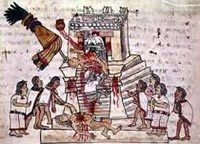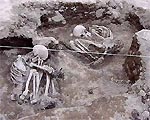The truth about the Indian sacrifice of sacrifices

A ceremony to kill the sacrifice of the Aztecs
It has long been debated whether the Aztecs and Mayans have the habit of killing savage sacrifices as recorded books of history. Now, archaeologists have collected many evidence to confirm this horrifying truth.
With advanced forensic tools, archaeologists have demonstrated that ancient sacrifices included a series of barbaric murder procedures, in which children were the main victims.
For decades, many researchers have suggested that the Spaniards occupying the Americas from the 16th-17th century distorted the truth to lower the Indian civilization. Some said that those sacrifices were aimed at prisoners. Others acknowledge that the Aztecs may be bloodthirsty, but the Mayans are not.
" We now have concrete evidence to corroborate the records ," said archaeologist Leonardo Lopez Lujan of Harvard University.
The transcripts have Indian illustrations along with the Spanish retelling that depicts savage forms. The victims were beheaded, opened their hearts, shot arrows, scratched, stoned, crushed, brazed, sawed, peeled, buried or thrown from the top of the temple. Children are primarily victims because they are considered clean and pure.
More than a decade ago, anthropologist Carmen Pijoan claimed to have found one of the first evidence of cannibalism in a pre-Aztec culture: human bones with cuts.
 Aztec human skeletons were unearthed in Ecatepec, Mexico. Last December, while excavating the land from the Aztec era in Ecatepec, north of Mexcio city, archaeologist Nadia Velez Saldana described the ritual of sacrifices. "The victims were burned to death or partially burned," said Velez Saldana. " We found a burial ground with bone fragments of four partially burned children, and traces of four other children burned completely ."
Aztec human skeletons were unearthed in Ecatepec, Mexico. Last December, while excavating the land from the Aztec era in Ecatepec, north of Mexcio city, archaeologist Nadia Velez Saldana described the ritual of sacrifices. "The victims were burned to death or partially burned," said Velez Saldana. " We found a burial ground with bone fragments of four partially burned children, and traces of four other children burned completely ."
Although these traces have not been shown that the victim was burned alive, there are paintings of people being tied and burned.
This excavation also revealed other clues that corroborated a painting dating from around 1600 - 1650, depicting body parts filled in large pans and people sitting around beating, in when the god of death observes.
" We have found such cookware. Besides the complete human bones, there are also fragments of cut bones, " said researcher Luis Manuel Gamboa.
In 2002, archaeologist Juan Alberto Roman Berrelleza published the results of a skeletal examination of 42 children, mostly six-year-old boys, who were performed at the Mayor temple of the Aztec era, in Mexico City. They all shared one characteristic: holes, pits or injections on the bones, it seemed that the children were crying out in pain.
"The crying cry of children during the ceremony will signal goodness. It can be created by slitting it ," Roman Berrelleza said.
Maya civilization flourished about 400 years before the Aztecs established Mexico City in 1325, also with the same sacrifice of sacrifices, anthropologist David Stuart at Harvard University.
At the end of the nineteenth and early twentieth centuries, researchers tried to separate the peaceful Mayans and savage Aztecs. They also try to prove that sacrificial killing is rare in Maya society.
But in the paintings and carvings, Stuart said, " we have found more and more similarities between the Aztecs and Maya. There is a Maya ceremony where the monk in the ridiculous outfit is gutting from a living person ".
Some Spanish texts coincide with found evidence, which describes the Aztec monks killing children and adults by confining them in caves or drowning.
"The problem is now only quantity," Lopez Lujan said. He said that the Spaniards had magnified the victims to make excuses for the eradication war, in which case 80,400 people were killed for sacrifice in a temple inauguration in 1487.
Researchers have simultaneously removed the hypothesis that cannibalism and cannibalism stem from the scarcity of Aztec food. Pre-Spanish cultures believe that the world will perish without sacrificial rituals. Meanwhile, the sacrificed victim is considered holy before being killed.
" It's hard for us to imagine. For them - sacrificed people - it's almost an honor ," Lujan said.
Intelligent performance
- The horrifying truth about the sacrifice of ancient people
- 5 terrifying archaeological discoveries related to human sacrifices
- New discoveries on human sacrifice: Help strengthen power in a classifying society
- Mexico found the body of the child who used the spirit in ancient Aztec temple
- The skull and the scary sacrifices in the ancient tomb of Maya were discovered
- Thanh Hoa: Detecting sacrifices in Dan Te Nam Giao
- Inside the Mayan goddess cave
- 7 very worldly ritual sacrifices of living people
- New explanation for the mass sacrifice of children
- Sacrifice ceremony through the newly discovered ancient temple
- Bacteria know how to cooperate and sacrifice for their kind
- Sacrifice strange people in Syria
 Discovered an ancient centipede fossil 99 million years old
Discovered an ancient centipede fossil 99 million years old Discovered bat-like dinosaurs in China
Discovered bat-like dinosaurs in China Discovered a 200-year-old bronze cannon of the coast
Discovered a 200-year-old bronze cannon of the coast Discover 305 million-year-old spider fossils
Discover 305 million-year-old spider fossils